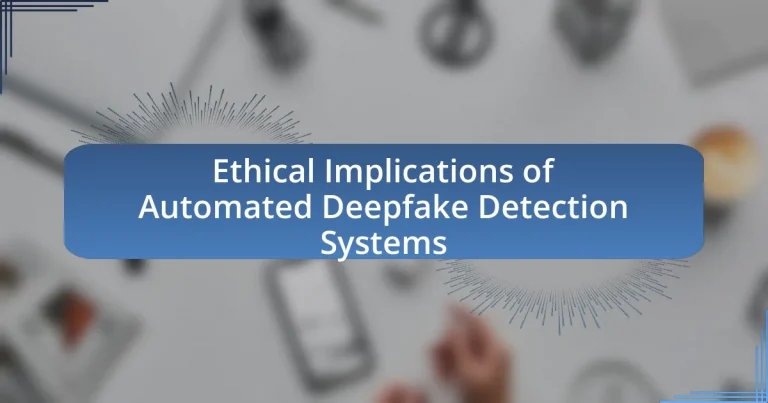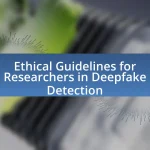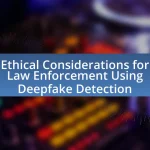Automated deepfake detection systems present significant ethical implications, particularly regarding privacy, consent, and the potential for misuse. These systems can infringe on individual privacy rights and may produce false positives, leading to unjust reputational damage. The article explores how these systems can function ethically through transparency, user consent, and adherence to various ethical frameworks, including utilitarianism and deontological ethics. It also addresses the challenges of algorithmic bias, privacy violations, and the importance of accountability in their deployment, while highlighting best practices for responsible usage and the role of public engagement in shaping future developments.
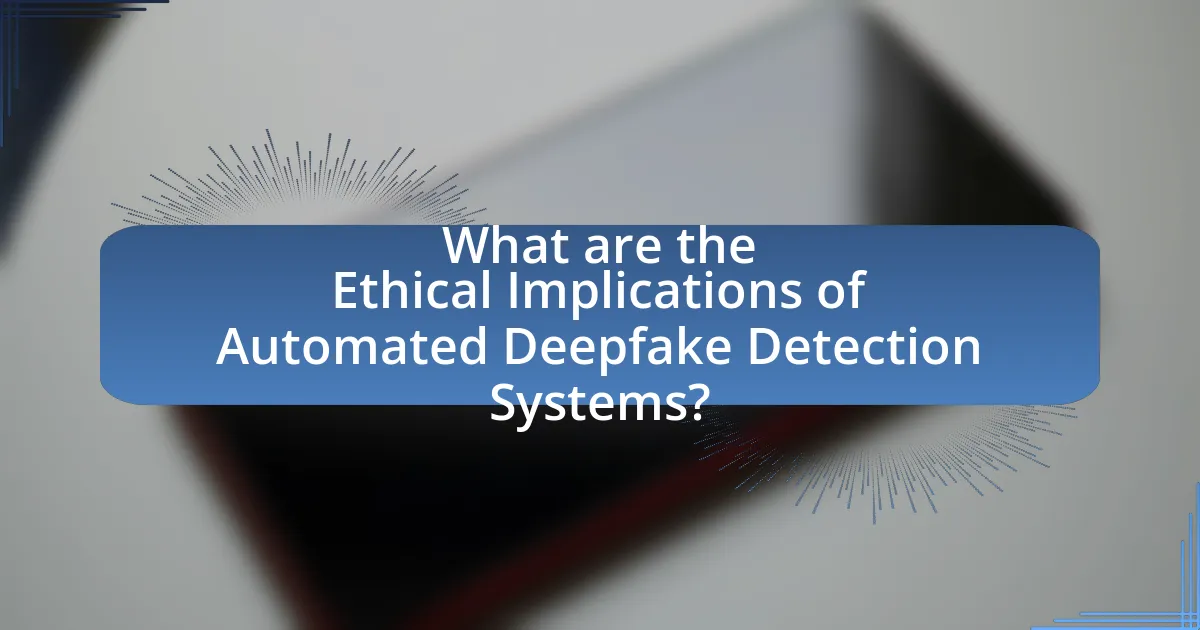
What are the Ethical Implications of Automated Deepfake Detection Systems?
Automated deepfake detection systems raise significant ethical implications, primarily concerning privacy, consent, and the potential for misuse. These systems can inadvertently infringe on individual privacy rights by analyzing and processing personal data without explicit consent, leading to unauthorized surveillance or profiling. Furthermore, the accuracy of these detection systems is not guaranteed; false positives can unjustly label innocent individuals as perpetrators of misinformation, damaging reputations and trust. Additionally, the deployment of such technologies can create a false sense of security, encouraging the spread of deepfakes under the assumption that they will be detected, which may embolden malicious actors. The ethical landscape is further complicated by the potential for bias in detection algorithms, which can disproportionately affect marginalized groups, leading to systemic discrimination.
How do automated deepfake detection systems function ethically?
Automated deepfake detection systems function ethically by employing algorithms that prioritize transparency, accuracy, and user consent. These systems analyze digital content for signs of manipulation while ensuring that their methodologies are disclosed to users, which fosters trust. For instance, ethical frameworks often require that detection systems provide clear information on how they identify deepfakes, thus allowing users to understand the technology’s limitations and capabilities. Additionally, ethical practices involve obtaining consent from individuals whose images or videos may be analyzed, thereby respecting privacy rights. Research indicates that adherence to ethical guidelines in technology deployment can enhance public confidence and mitigate misuse, as seen in studies by the Partnership on AI, which emphasize the importance of responsible AI practices.
What ethical frameworks apply to the development of these systems?
The ethical frameworks that apply to the development of automated deepfake detection systems include utilitarianism, deontological ethics, and virtue ethics. Utilitarianism focuses on maximizing overall happiness and minimizing harm, which is relevant as these systems aim to protect individuals and society from the potential dangers of deepfakes. Deontological ethics emphasizes adherence to rules and duties, highlighting the importance of transparency and accountability in the development and deployment of these technologies. Virtue ethics centers on the character and intentions of the developers, advocating for responsible innovation that prioritizes ethical considerations. These frameworks collectively guide the ethical development of deepfake detection systems by ensuring that they serve the public good while respecting individual rights and promoting moral integrity.
How do biases in algorithms affect ethical considerations?
Biases in algorithms significantly impact ethical considerations by perpetuating discrimination and inequality. When algorithms are trained on biased data, they can produce outcomes that favor certain groups over others, leading to unfair treatment in areas such as hiring, law enforcement, and credit scoring. For instance, a study by ProPublica found that a risk assessment algorithm used in the criminal justice system was biased against African American defendants, falsely flagging them as higher risk compared to white defendants. This highlights how algorithmic bias can undermine fairness and justice, raising ethical concerns about accountability and transparency in automated decision-making processes.
What are the potential risks associated with automated deepfake detection?
Automated deepfake detection systems carry several potential risks, including false positives, privacy violations, and the potential for misuse. False positives can lead to innocent individuals being wrongly accused of creating or distributing deepfakes, which can damage reputations and lead to legal consequences. Privacy violations may occur if detection systems require access to personal data or images without consent, infringing on individual rights. Additionally, these systems can be misused by malicious actors to target specific individuals or groups, potentially leading to harassment or misinformation campaigns. The implications of these risks highlight the need for careful implementation and oversight of automated deepfake detection technologies.
How can false positives impact individuals and society?
False positives can significantly harm individuals and society by leading to wrongful accusations, loss of reputation, and erosion of trust in technology. For instance, in the context of automated deepfake detection systems, a false positive may incorrectly label an innocent person as a creator of malicious content, resulting in social stigma and potential legal consequences. According to a study published in the journal “Nature,” false positives in facial recognition systems have been shown to disproportionately affect marginalized communities, exacerbating existing societal inequalities. This not only impacts the individuals directly involved but also undermines public confidence in technological solutions, which can hinder the adoption of beneficial innovations.
What are the implications of privacy violations in detection processes?
Privacy violations in detection processes can lead to significant ethical and legal repercussions. These violations undermine individual autonomy and trust, as personal data may be collected and analyzed without consent, violating privacy rights established by regulations such as the General Data Protection Regulation (GDPR). Furthermore, unauthorized data usage can result in discrimination or profiling, where individuals are unfairly targeted based on sensitive information. Studies indicate that breaches of privacy can erode public confidence in technology, leading to resistance against automated systems, which ultimately hampers their effectiveness and adoption.
What benefits do automated deepfake detection systems provide?
Automated deepfake detection systems provide significant benefits by enhancing the ability to identify manipulated media, thereby protecting individuals and organizations from misinformation and potential harm. These systems utilize advanced algorithms and machine learning techniques to analyze video and audio content for inconsistencies that indicate tampering. For instance, a study published in 2020 by the University of California, Berkeley, demonstrated that automated detection systems could achieve over 90% accuracy in identifying deepfakes, showcasing their effectiveness in combating the spread of deceptive content. By ensuring the authenticity of media, these systems help maintain trust in digital communications and safeguard against the malicious use of deepfakes in various contexts, including politics and personal reputations.
How do these systems enhance trust in digital media?
Automated deepfake detection systems enhance trust in digital media by accurately identifying manipulated content, thereby reducing the spread of misinformation. These systems utilize advanced algorithms and machine learning techniques to analyze videos and images for signs of tampering, which helps users discern authentic media from deceptive alterations. For instance, a study published in the journal “Nature” demonstrated that deepfake detection algorithms could achieve over 90% accuracy in identifying synthetic media, reinforcing their reliability as tools for maintaining media integrity. By providing users with the ability to verify the authenticity of digital content, these systems foster a more trustworthy media environment.
What role do they play in combating misinformation?
Automated deepfake detection systems play a crucial role in combating misinformation by identifying and flagging manipulated media content. These systems utilize advanced algorithms and machine learning techniques to analyze videos and images for signs of alteration, thereby helping to prevent the spread of false information. For instance, a study published in the journal “Nature” demonstrated that automated detection systems could accurately identify deepfakes with over 90% precision, significantly reducing the likelihood of misinformation reaching the public. By providing timely alerts and verification tools, these systems enhance media literacy and promote accountability among content creators, ultimately contributing to a more informed society.
How do ethical implications influence public perception of these systems?
Ethical implications significantly influence public perception of automated deepfake detection systems by shaping trust and acceptance. When these systems are perceived as fair, transparent, and accountable, public confidence increases, leading to broader acceptance. Conversely, concerns about privacy violations, potential misuse, and biases can lead to skepticism and resistance. For instance, a study by the Pew Research Center found that 70% of Americans expressed concern about the ethical use of AI technologies, indicating that ethical considerations directly impact how people view these systems.
What are the regulatory considerations for automated deepfake detection?
Regulatory considerations for automated deepfake detection include compliance with data protection laws, transparency requirements, and accountability measures. Data protection laws, such as the General Data Protection Regulation (GDPR) in Europe, mandate that any automated system processing personal data must ensure privacy and security, impacting how deepfake detection algorithms are developed and deployed. Transparency requirements necessitate that users are informed about the use of such technologies, including the potential for false positives or negatives. Accountability measures involve establishing clear guidelines for liability in cases where automated detection fails, ensuring that developers and users of these systems are held responsible for their outcomes. These considerations are crucial for fostering trust and ethical use of automated deepfake detection technologies.
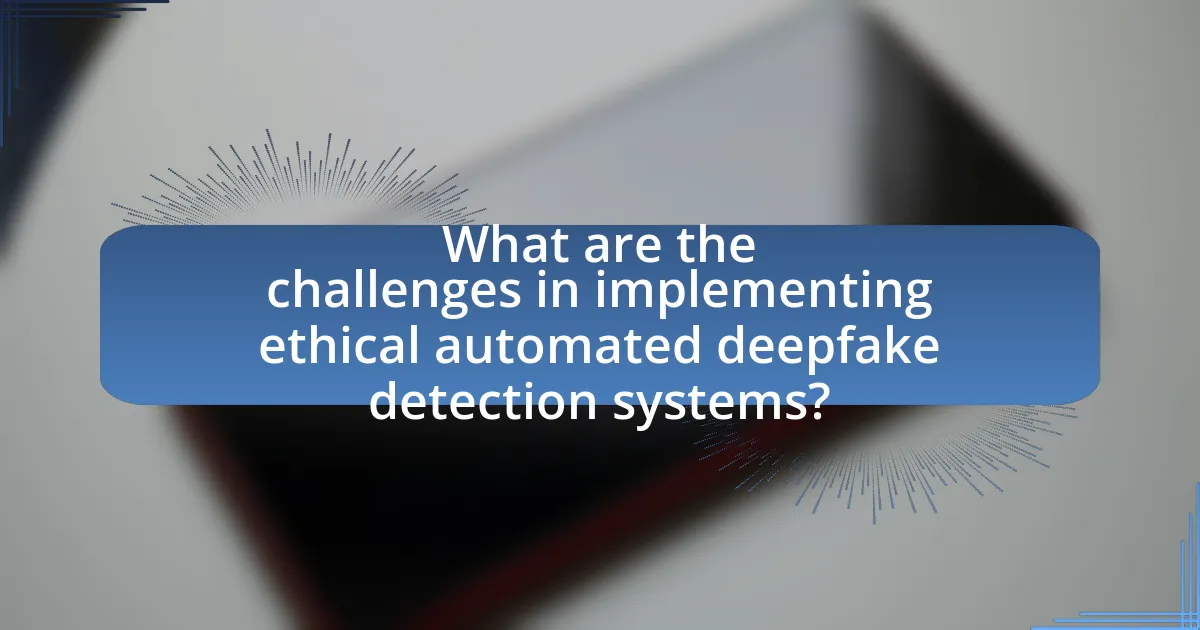
What are the challenges in implementing ethical automated deepfake detection systems?
Implementing ethical automated deepfake detection systems faces several challenges, primarily related to accuracy, bias, privacy, and the potential for misuse. Accuracy is crucial, as false positives can unjustly label legitimate content as fake, while false negatives may allow harmful deepfakes to proliferate. Bias in detection algorithms can lead to unequal performance across different demographics, exacerbating existing inequalities. Privacy concerns arise when systems require access to personal data for training, raising ethical questions about consent and data protection. Additionally, the potential for these systems to be misused by malicious actors to create countermeasures against detection further complicates their ethical deployment. These challenges highlight the need for careful consideration and robust frameworks to guide the development and implementation of such technologies.
How can developers ensure transparency in detection algorithms?
Developers can ensure transparency in detection algorithms by implementing clear documentation and providing access to the algorithm’s decision-making processes. This includes detailing the data sources, model architecture, and training methodologies used, which allows stakeholders to understand how decisions are made. For instance, the use of explainable AI techniques, such as LIME or SHAP, can help elucidate how specific inputs influence outputs, thereby enhancing interpretability. Research indicates that transparency fosters trust and accountability, as seen in studies highlighting that users are more likely to accept automated systems when they understand their workings.
What measures can be taken to mitigate algorithmic bias?
To mitigate algorithmic bias, organizations can implement diverse training datasets, conduct regular audits, and employ bias detection tools. Diverse training datasets ensure that algorithms are exposed to a wide range of scenarios and demographics, reducing the risk of biased outcomes. Regular audits help identify and rectify biases in algorithmic decision-making processes, while bias detection tools can analyze algorithms for fairness and accuracy. Research indicates that these measures can significantly improve the fairness of automated systems, as evidenced by studies showing that diverse datasets lead to more equitable performance across different demographic groups.
How can user consent be integrated into detection processes?
User consent can be integrated into detection processes by implementing transparent opt-in mechanisms that allow users to provide explicit permission for their data to be used in detection algorithms. This approach ensures that individuals are informed about how their data will be utilized, aligning with ethical standards and legal requirements such as the General Data Protection Regulation (GDPR), which mandates that consent must be freely given, specific, informed, and unambiguous. By incorporating user consent into the design of detection systems, developers can foster trust and accountability, ultimately enhancing the ethical framework surrounding automated deepfake detection.
What role does accountability play in the deployment of these systems?
Accountability is crucial in the deployment of automated deepfake detection systems as it ensures responsible use and management of these technologies. When organizations implement such systems, they must establish clear lines of responsibility for the outcomes, including the accuracy of detection and the potential consequences of false positives or negatives. For instance, a study by the University of California, Berkeley, highlights that accountability mechanisms can mitigate risks associated with misuse, ensuring that stakeholders are answerable for the decisions made by these systems. This fosters trust among users and the public, as it demonstrates a commitment to ethical standards and transparency in the technology’s application.
Who is responsible for the consequences of detection errors?
The developers and operators of automated deepfake detection systems are responsible for the consequences of detection errors. This responsibility arises from their role in designing, implementing, and maintaining the technology, which directly impacts the accuracy and reliability of the detection process. For instance, if a detection system incorrectly identifies a legitimate video as a deepfake, the creators of that system are accountable for the resulting misinformation and potential harm caused to individuals or organizations affected by the error.
How can accountability be enforced in the tech industry?
Accountability in the tech industry can be enforced through regulatory frameworks, ethical guidelines, and transparent practices. Regulatory bodies can establish laws that require tech companies to adhere to specific standards, such as data protection and ethical AI use, which can be monitored and enforced through penalties for non-compliance. For instance, the General Data Protection Regulation (GDPR) in Europe imposes strict rules on data handling, holding companies accountable for breaches. Additionally, companies can adopt internal ethical guidelines that promote responsible innovation and establish clear consequences for violations. Transparency in algorithms and decision-making processes can also enhance accountability, as it allows stakeholders to scrutinize practices and hold companies responsible for their actions.
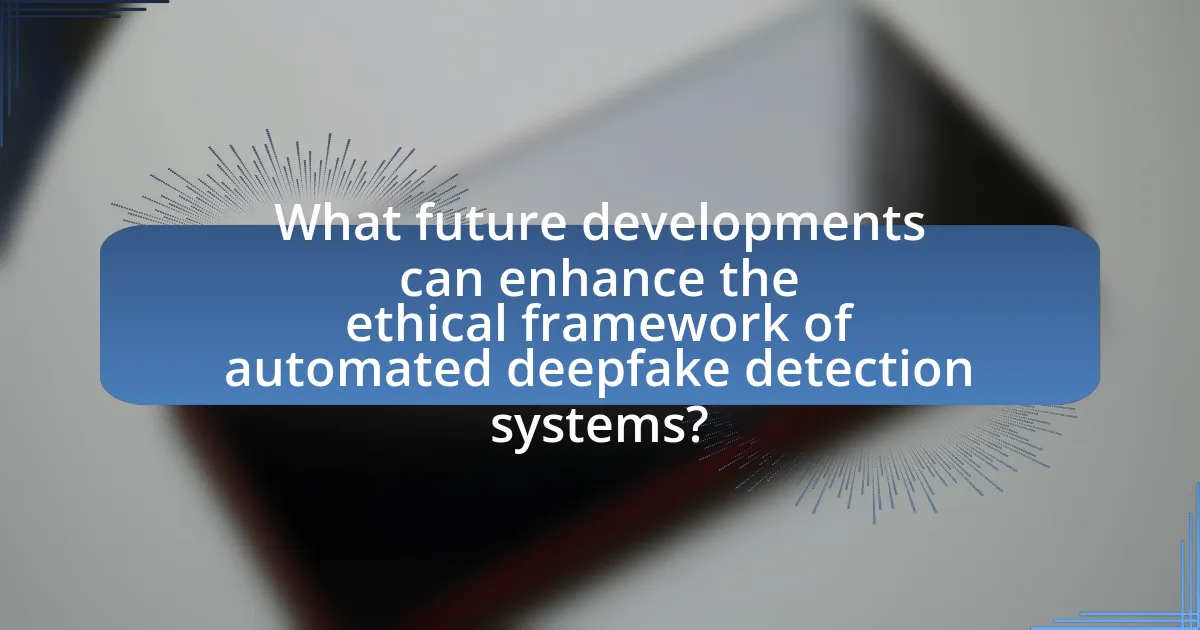
What future developments can enhance the ethical framework of automated deepfake detection systems?
Future developments that can enhance the ethical framework of automated deepfake detection systems include the integration of transparent algorithms and robust accountability measures. Transparent algorithms allow users to understand how detection systems operate, fostering trust and enabling informed consent. For instance, the implementation of explainable AI techniques can clarify decision-making processes, which is crucial for ethical compliance. Additionally, establishing accountability measures, such as regulatory frameworks and industry standards, can ensure that developers and organizations are held responsible for the misuse of deepfake technology. Research indicates that ethical guidelines, like those proposed by the Partnership on AI, emphasize the importance of accountability in AI systems, reinforcing the need for these developments to mitigate potential harms associated with deepfakes.
How can interdisciplinary collaboration improve ethical standards?
Interdisciplinary collaboration can improve ethical standards by integrating diverse perspectives and expertise, which enhances the understanding of ethical implications in complex fields like automated deepfake detection systems. For instance, collaboration between ethicists, technologists, and legal experts can lead to the development of comprehensive guidelines that address potential misuse and societal impacts of deepfake technology. Research indicates that interdisciplinary teams are more effective in identifying ethical dilemmas and proposing solutions, as evidenced by a study published in the journal “Science and Engineering Ethics,” which found that diverse teams are better at recognizing biases and ethical concerns in technology development. This collaborative approach fosters a more robust ethical framework that can adapt to the evolving challenges posed by automated systems.
What insights can ethicists provide to technology developers?
Ethicists can provide technology developers with critical insights into the moral implications and societal impacts of automated deepfake detection systems. These insights help developers understand the potential for misuse, such as infringing on privacy rights or enabling censorship, which can arise from deploying such technologies. For instance, ethicists emphasize the importance of transparency in algorithms to prevent bias and ensure accountability, as highlighted in the 2020 report by the AI Ethics Lab, which discusses the ethical frameworks necessary for responsible AI development. By integrating these ethical considerations, technology developers can create systems that not only detect deepfakes effectively but also uphold societal values and protect individual rights.
How can public engagement shape the future of these systems?
Public engagement can significantly shape the future of automated deepfake detection systems by fostering transparency and accountability in their development and deployment. When the public actively participates in discussions about these systems, it encourages developers to consider ethical implications, such as privacy concerns and potential biases in algorithms. For instance, research by the Berkman Klein Center for Internet & Society highlights that public input can lead to more inclusive design processes, ensuring that diverse perspectives are integrated into technology solutions. This engagement can also drive regulatory frameworks that prioritize ethical standards, as seen in the European Union’s proposed regulations on AI, which emphasize the importance of public consultation in shaping policies.
What best practices should be adopted for ethical automated deepfake detection?
Best practices for ethical automated deepfake detection include ensuring transparency in detection algorithms, maintaining user privacy, and implementing robust validation processes. Transparency allows users to understand how detection systems operate, fostering trust and accountability. Protecting user privacy involves minimizing data collection and ensuring that any data used for detection is anonymized. Robust validation processes, such as cross-referencing with multiple detection methods, enhance the reliability of results. These practices are supported by guidelines from organizations like the Partnership on AI, which emphasizes ethical considerations in AI deployment.
How can ongoing training and education improve ethical awareness?
Ongoing training and education can significantly improve ethical awareness by providing individuals with the knowledge and skills necessary to recognize and address ethical dilemmas. Continuous learning ensures that individuals stay updated on ethical standards, legal regulations, and best practices relevant to their field, particularly in rapidly evolving areas like automated deepfake detection systems. For instance, a study by the Ethics and Compliance Initiative found that organizations with robust ethics training programs report higher levels of ethical behavior among employees, demonstrating a direct correlation between education and ethical awareness. This ongoing engagement fosters a culture of ethical decision-making, enabling individuals to navigate complex situations with greater confidence and integrity.
What guidelines should be established for responsible usage?
Guidelines for responsible usage of automated deepfake detection systems should include transparency, accountability, and user education. Transparency requires that users understand how the detection algorithms function, including their limitations and potential biases. Accountability mandates that developers and organizations using these systems take responsibility for their outcomes, ensuring that misuse is addressed and mitigated. User education involves training users on the ethical implications of deepfakes and the importance of verifying information before sharing. These guidelines are essential to foster trust and promote ethical practices in the deployment of such technologies.
